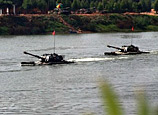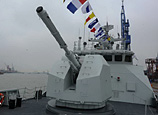
The Liaoning Ship, the first aircraft carrier of the Navy of the Chinese People's Liberation Army (PLA), dropped anchor for the first time in a military port in Qingdao of east China's Shandong province on the morning of February 27, 2013. Reporters from the PLA Daily interviewed Zhang Junshe, deputy director of the Naval Military Academic Institute under the Navy of the PLA, for his interpretation of this landmark event.
China's military port for aircraft carriers has support capability to berth aircraft carriers
The Liaoning Ship's berthing at the military port in Qingdao marks a significant milestone in the history of development of Chinese aircraft carrier. "The Liaoning Ship's departure from the shipyard and anchoring at the military port signifies the fact that it has met the requirements in terms of the ship hull, power system, electronic equipment, rigs and so on, and no longer needs the shipyard debugging," said Zhang Junshe.
He continued to say that the anchoring of the aircraft carrier in the dedicated base also indicates that China's newly-built military port for aircraft carriers has already had the supporting capability to dock aircraft carriers and provide such logistic support as water, electricity, gas, fuel and so on during the berthing of aircraft carriers.
Liaoning Ship needs two to three years to complete ship-borne aircraft and CTF joint trainings
The Liaoning Ship has successfully accomplished the tasks of take-off, landing and other training of carrier-borne aircraft since last November. Regarding the follow-up trainings, Zhang Junshe told reporters that the Liaoning Ship's berthing at the home port has laid down the foundation for the full-swing future testing of related weaponry and equipment, as well as the carrier-aircraft and the carrier taskforce (CTF) joint trainings. A series of trainings still needs to be done in the future. Generally speaking, it will take about two years to complete the CTF training based on the experiences of other countries.
Since the Liaoning Ship's CTF training is short of experience to learn from, it needs to feel the way from the very beginning. It may probably take two to three years in order to complete the carrier-aircraft and the CTF joint trainings, he added.
Home port for aircraft carriers is deep-water port accessible to 100,000-ton ship
According to Zhang Junshe, based on the experience of site selection of carrier home ports by foreign countries, a carrier home port should have good physiographic conditions to provide daily supply and support for the CTF. At the same time, such factors as the needs of the national security strategy, the direction of strategic defense, defense depth, the development level of weaponry and equipment, and so forth, should also be considered.
He also said that the home port for aircraft carriers should be a deep-water port with a channel depth between 12 to 20 meters, the maximum depth of which should exceed 25 meters in order to allow 100,000-ton ships to sail in and out of the harbor. A carrier home port should not only provide supplies and maintenance for aircraft carriers, but also provide support for the entire CTF, including the destroyers, frigates, submarines, comprehensive supply ships and others.


















![]()
